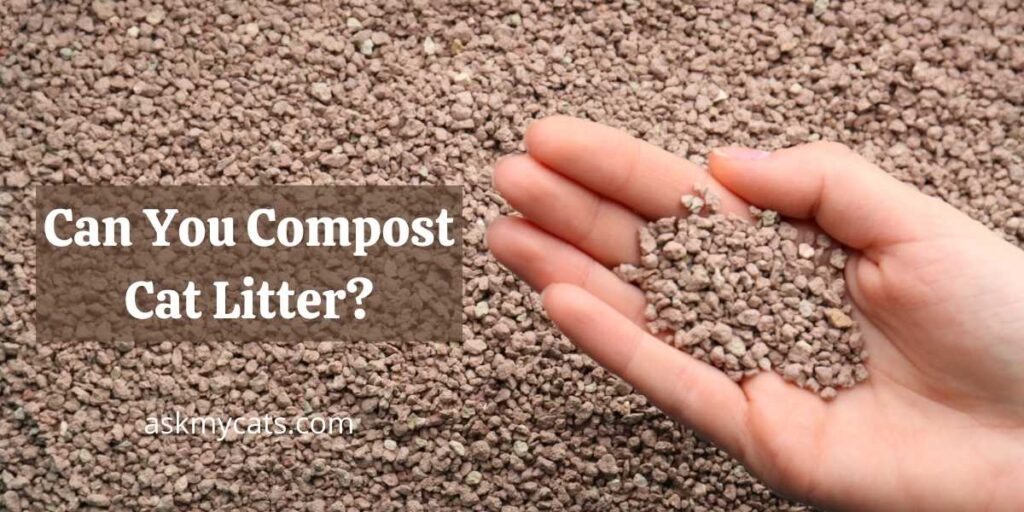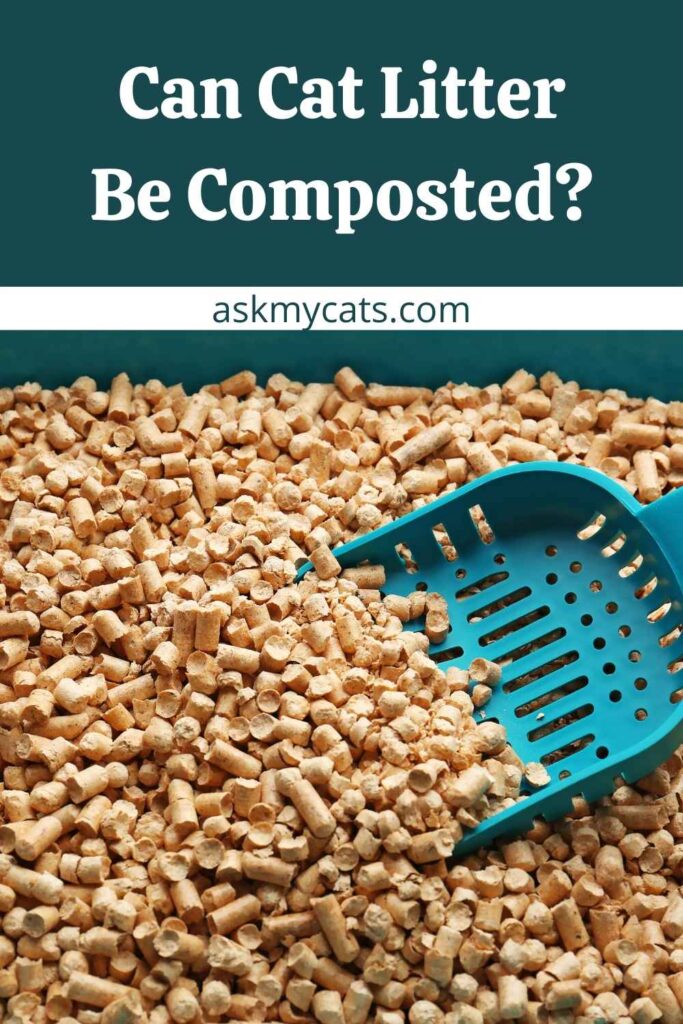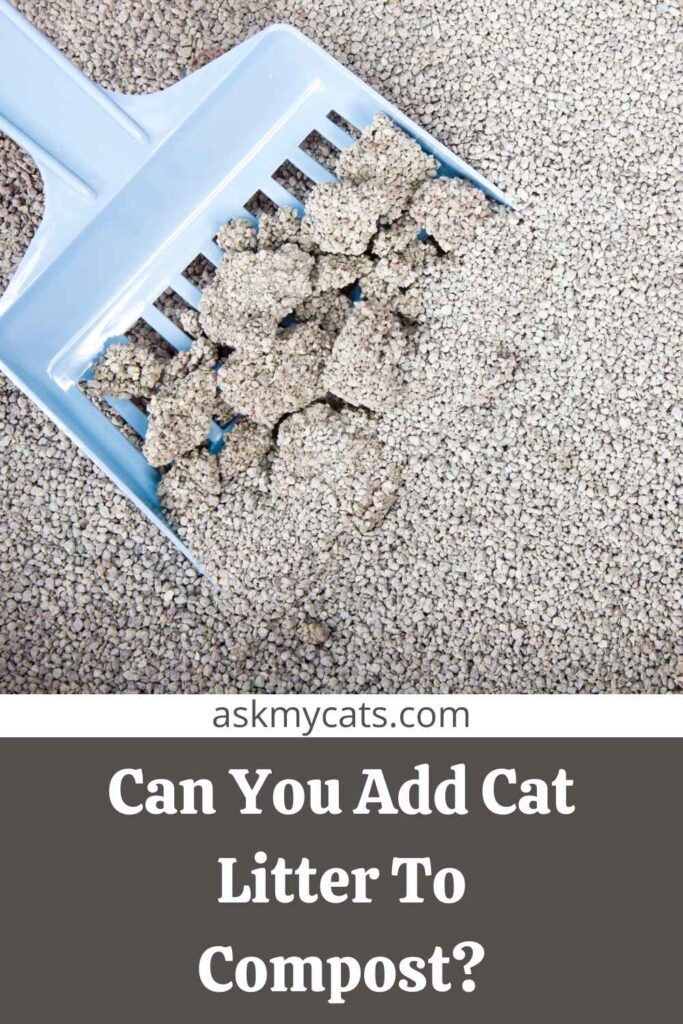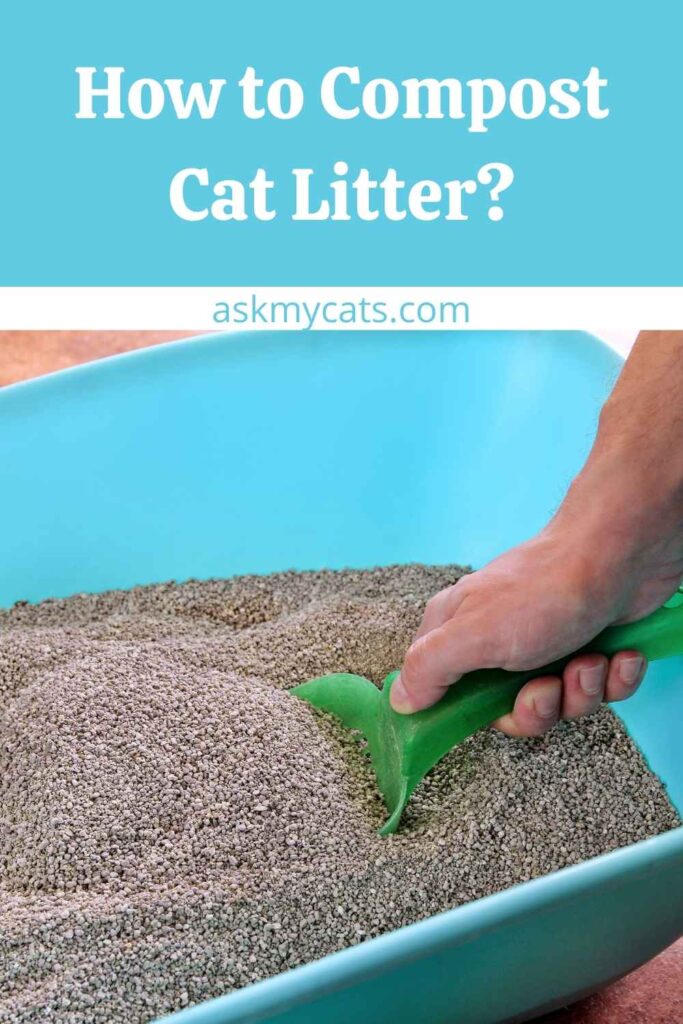The most ecologically responsible approach to dispose of biodegradable cat litter is to compost it. It decreases the quantity of garbage sent to landfills while also producing nutrient-rich humus that may be used to feed decorative plants.
However, composting yard waste or food scraps is not as straightforward as it appears.
Yes, you can compost cat litter, but it all depends on the sort of litter you use, how you compost it, and what you want to do with the resulting compost.
Before adding your cat’s litter box contents to your composting process, ensure you have all the information. Let’s go a little more into this and see if we can figure out any solutions.


Give Your Cat the Perfect Day
Get the Free Ebook!
Can Cat Litter Be Composted?
Yes, cat litter can be composted.

Cat litter can be composted in some cases. Composting is possible with any biodegradable cat litter that is devoid of additives. Clay litter and plant-based litter with chemical additions cannot be composted.
You’ve probably heard that kitty litter may harm pregnant mothers and their unborn children. Individuals with weakened immune systems, on the other hand, may be at risk.
This is due to the fact that cat faeces can harbour a variety of viruses and parasites, including Toxoplasma gondii.
Unfortunately, compost seldom reaches the 165° F temperature necessary to kill Toxoplasma gondii.
You risk spreading hazardous germs and parasites by putting humus-containing cat excrement on or near food plants. Only attractive plants should be grown with it.
Composting is possible with any biodegradable, plant-based cat litter with no additives. Wood, paper, wheat, grass, maize, tofu, and walnut shell litter are examples. Cat litters made of clay and crystal cannot be composted.
Can You Add Cat Litter To Compost?
Yes, you can add cat litter to compost.

When done correctly, composting cat litter is completely safe. However, if you’re not careful, you may cause more harm than good. Pathogens, Toxoplasma gondii, and other parasites can spread from a poorly situated or maintained compost pile.
Never use compost containing cat excrement on or near food plants.
Avoid cross-contamination between piles if you’re also preparing compost for an edible garden. Keep your regular compost pile at least 20 feet away from and uphill from any cat waste mound.
Keep cat’s litter compost piles out of reach of children, pets, and animals. It’s a good idea to screen off the area. After handling compost, thoroughly wash your hands.
Pregnant women and people with weakened immune systems should avoid composting litter.
To begin composting, all you’ll need is a place to compost and a shovel or pitchfork to turn the pile. We found a long-stemmed moisture meter and a compost thermometer quite helpful, while they are not required.
A bare-earth compost pile is best. It permits worms and other creatures to aerate the compost pile while transporting essential nutrients throughout your lawn and garden.
This strategy is best suited for yards with sufficient space and no dogs, children, or wildlife that may cause the pile to be tampered with. In any case, it’s a good idea to screen off the area where your compost is stored to keep unwanted visitors out.
If this isn’t practicable, a compost bin will suffice. A digester is a compost bin enclosed on all sides of the bottom and is exposed to the soil. Tumblers are compost containers that are entirely contained and may be spun to aerate the compost.
While either option will suffice, a digester offers many of the same advantages as an open compost pile.
Making a DIY bin to save a few dollars is also not difficult. Construct a wood box at least three cubic feet in volume, if not somewhat larger. Use non-treated, non-composite wood whenever possible.
A giant plastic garbage can with a few half-inch holes drilled into the bottom of the bottoms removed also be used as a practical and low-cost beginning bin.
To be effective at composting, you’ll need four essential elements. Carbon, nitrogen, oxygen, and water are the four elements that make up the universe.
Maintaining a balanced mix of carbon and nitrogen while allowing the pile adequate air and moisture is essential for a healthy compost pile.
How to Compost Cat Litter?
Composting cat litter is as easy as layering carbon and nitrogen sources in alternate layers while keeping an eye on temperature and moisture.
Organic waste, such as food scraps and cat faeces, is broken down by microbes over time. Leaving nutrient-dense compost behind that may be utilized to feed ornamental plants.
Compost gets its energy from carbon-rich materials, sometimes known as brown stuff. Branches, dried leaves, eggshells, straw, and biodegradable cat litter are examples.
Avoid using chemically processed sawdust or wood chips that may contain machine lubricants. Avoid them if your lawn or plants have been treated with pesticides or herbicides. Also, avoid utilizing perennial weeds if you don’t want to disseminate seeds.
Green material, or nitrogen-rich materials, gives compost the microbes it needs to oxidize carbon. Examples are food leftovers, fresh grass clippings, green leaves, and cat excrement.

1. Starting Your Compost Pile
Make a compost pile’s foundation. Begin by covering the whole bottom of the covered bin with a three to four-inch layer of dirt, sawdust, dried leaves, or straw.
This enhances airflow while allowing drainage until the soil is designated for open-air compost heaps or bottomless compost containers.
Combine brown and green materials in alternating layers. Maintain a smooth, rounded form with a flattened top. Keep the cat waste to a minimum at first.
Last but not least, add your first batch of cat excrement. This should be placed in the compost pile’s top centre and then thoroughly covered with a layer of brown stuff.
2. Adding to the Heap
It’s better to stockpile brown and green materials rather than adding them as you go after your compost pile is up and running. This ensures that enough of each is available to layer properly.
Brown items should be kept in a dry location in your yard. Most greens may be stored in any container, but they should be frozen if left out for more than a week. You can separately store cat faeces in an airtight container.
Add alternate layers of three to four inches of browns and greens until you’ve accumulated enough browns and greens. Always add a layer of brown material to the top of the pile. This top layer can be removed and reused, but it is necessary for composting.
If your compost pile becomes too big, repeat the process and create another one.
3. Maintain Carbon to Nitrogen Ratio
Brown stuff makes up far more of a good compost pile than green. By weight, about thirty parts carbon to one part nitrogen is ideal.
If you want to be very scientific about it, several valuable charts are available.
However, we advise against overthinking the ratio. The truth is that you can produce compost as long as you use the right ingredients, with a lot more brown than green, and provide enough air and moisture.
With each batch you produce, you’ll become more confident as you discover what works and what doesn’t.
4. Monitor Moisture Content
Your compost heap should be kept moist but not wet at all times. Microorganism activity will be limited by a lack of moisture, delaying or interrupting the composting process.
Anaerobic conditions and a foul-smelling compost pile can result from too much water. A moisture meter can help you keep track of the moisture level in the centre of your pile, but it’s not required.
Water should never be introduced directly from a hose due to the importance of temperature. The temperature of your compost pile can be lowered by using cool tap water, which might cause the composting process to be disrupted.
Instead, fill a bucket halfway with water and let it out in the sun for a day or two to warm up.
You can cover your compost with a rug or carpet if you live in an arid region. This will assist in keeping moisture in the pile while allowing it to breathe.
Cover the pile loosely with a weatherproof tarp during heavy rains or highly damp conditions.
5. Maintain Oxygen Balance
Add enough bulky, brown stuff to the pile to allow air movement. Even if you don’t turn your pile, coarse brown materials like hay and dry leaves offer enough circulation for it to breathe.
You’ll need to aerate your compost pile with a pitchfork or shovel once every few weeks if you’re mainly utilizing less-bulky brown materials like pellet litter or sawdust. However, please do not overdo it. You can overturn your compost if you do it too frequently.
6. Final Product
Your compost should be aged until it is black and soil-like, smells deep and earthy, crumbles when touched, and all of the original elements have decomposed completely.
The length of time it takes is determined by the size of your compost pile, the materials you utilized, how effectively you handled it, and the climate in which you live.
Compost can be ready in three to six months on average. However, cat faeces compost must cure for at least a year and might take up to eighteen months before it is ready.
Using compost before it has fully cured may be hazardous to plants and can make people sick if not handled correctly.
How Long Does Cat Litter Take To Compost?
Compost can be ready in three to six months on average. However, cat faeces compost must cure for at least a year and might take up to eighteen months before it is ready.
Biodegradable cat litter, unlike clay and silica cat litter, decomposes. If no heat is used, the entire process usually takes at least a year. It might take months if there is a lot of heat.
Using the cold composting method, it will take at least a year to compost leftover cat litter. Hot composting might take as little as a few months, but you’ll have to put in a bit more work.
Frequently Asked Questions
Can worms compost cat litter?
Suppose cat predation can be avoided, and the worms can adjust to the chemical metabolites of regularly used feline items. In that case, a vermicomposting system is a feasible alternative to a typical litter pan.
Can you compost World’s Best cat litter?
Most clumping litters are clay-based, which is terrible for compost, or include questionable chemicals. It is recently been discovered that World’s Best Cat Litter is a corn-based clumping litter. The material is both practical and biodegradable.
How do you neutralize cat poop in soil?
Remove any faeces you find, as well as any soil it may have come into contact with. It’s best to place it in a plastic bag and throw it away in your trash container. Unless there is a considerable amount of urine in a limited region, cat urine should not be a concern for your soil. Then, dilute it in the ground with plenty of water.
Final Words
Composting biodegradable cat faeces is the most environmentally friendly method of litter disposal. It reduces the amount of garbage sent to landfills while also producing nutrient-rich humus for lawns and decorative plants.
If you’re nervous about the procedure, start by bagging and discarding your cat’s waste and composting only the used litter.
Ask your questions in the comments section below.
